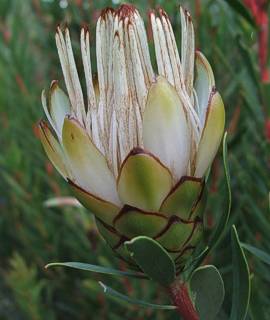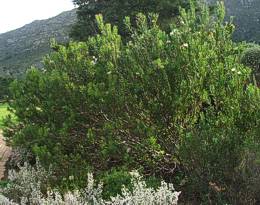Protea lanceolata
Protea lanceolata E.Mey. ex Meisn.
Family: Proteaceae
Common names: lance-leaf protea, lance-leaf sugarbush (Eng.); smalblaarsuikerbos (Afr.); isiqalaba (Xho.)
SA Tree No: 90.1
Introduction
With its neat shape, white flower heads and tolerance for coastal and alkaline conditions, Protea lanceolata makes a perfect windbreak for a coastal fynbos garden, and it will attract birds.

Description
Description
Protea lanceolata is an erect shrub, 2-4 m high with a trunk diameter up to 100 mm. Hairless upright stems, 4-6 mm thick, branch from the trunk, giving an up to 2 m diameter shrub. Young stems are often reddish. The leaves are lanceolate to narrowly lanceolate, hairless, smooth, 50-75 x 5-15 mm. Leaf tips are rounded and rarely pointed. White flower heads appear at the tips of the stems from autumn until spring (April to October) with peak flowering in early to midwinter (May to July). Both sexes are present in each flower.
The involucral receptacle is concave. The flower heads are obconic to broadly obconic 70-80 x 50-70 mm. The flower head is made up of two distinct series of involucral bracts. The whorl of bracts at the base of the inflorescence, the outer series, is made up of bracts that are green with brown margins, hairless, tightly overlapping and acute.

The bracts of the inner series are oblong to ovate to linear-lanceolate, concave, acute and widely splayed. They are greenish white to white and hairless or fringed with tiny red hairs at the base. The flowers are white, sparsely covered in reddish hairs with densely hairy tips. As the flower head opens the flowers collapse, giving the flower head an untidy appearance. Seeds are retained in a spherical, cone-like seed head. The seed heads are retained on the bush for many years, and when not in flower, this species is often mistaken for a conebush (Leucadendron species).
Conservation Status
Status
Protea lanceolata has a Red List status of Least Concern (Raimondo et al. in prep.) meaning that it is not threatened. Previously it was considered Vulnerable as its habitat was threatened by invasion by alien plants, in particular the Australian Acacia cyclops (rooikrans). Although this species is far more common and widespread than previously thought, a significant portion of its habitat is infested with rooikrans and it should continue to be monitored.
Other threats to this species are urbanization, golf courses, clearing of veld for thatch farming, too frequent fires and too infrequent fires.
Too frequent fire is a threat because, if a fire comes too soon after an earlier fire, the plants have not had enough time to build up sufficient seed reserves. Too infrequent fire is a threat because in older populations, after 30-40 years, the mature, seed-bearing plants start to die, and this causes the seed bank to decline until there are not enough seeds to maintain a viable population.
Distribution and habitat
Distribution description
Protea lanceolata is endemic to the southern Cape and occurs from Potberg and Riversdale to Robinson Pass. This exclusively coastal protea grows in close proximity to the sea on deep, white, slightly calcareous sands, often found where ecotones of fynbos and thicket merge. It also occurs on clay-textured tertiary gravels and is found adjacent to limestone outcrops. This protea is therefore salt/wind hardy and will tolerate alkaline soils. It occurs at altitudes of 0-200 m in a winter rainfall area.
Derivation of name and historical aspects
History
The species name is derived from the Latin word, lancea, meaning spear or lance and the root of the word lanceolate, which describes the lance-shaped leaves.
Protea lanceolata was first discovered between Mossel Bay and Cape St Blaize in 1814 by William John Burchell, an English explorer and naturalist. He was returning from an almost four-year journey exploring southern Africa. However, it was only described by J.F. Drège from specimens collected near the Gouritz River Mouth almost half a century later in 1833.
This protea was introduced into cultivation at Kirstenbosch in 1913 from seeds collected at Albertinia by Dr John Muir and is still in horticulture today.

The Proteaceae is one of the most prominent flowering plant families. There are about 1400 species in more than 60 genera, such as Protea, Leucadendron, Leucospermum, Serruria and Paranomus to name a few, which occur in southern hemisphere countries. Australia has the most, with 45 genera, followed by Africa with 14 genera, of which more than 330 species occur in the southwestern Cape. Other countries where they occur include Central and South America, islands east of New Guinea, New Caledonia, Madagascar, Southeast Asia, New Guinea and New Zealand.
The family is an ancient one and existed in the time of the dinosaurs. The Proteaceae are found in numerous forms from groundcover types to trees. This may be the reason behind its original naming by Carl Linnaeus, the father or taxonomy. Proteus was the mythological Greek god who could see the future and always spoke the truth, but in order to extract a prophecy, one had to grasp him tightly while he changed into numerous animate or inanimate forms.
Ecology
Ecology
This is a social Protea, occurring in large, dense, isolated populations. Birds pollinate the flowers. Fynbos is a fire-dependent ecosystem and Protea lanceolata has adapted to this. Seeds are retained on the plants inside cone-like seed heads, where they are safe from the flames. After the fire, the seed heads open and release the seeds, which are dispersed by the wind, germinate after rain, grow and replace the mature plants that were killed in the fire.
Uses
Use
The flower heads are at their most attractive just before opening but this species is considered to be of little value or attraction as a cut flower, due to the small flowers having an untidy, splayed look, even though it does have a relatively long vase life. Due to its adaptability in cultivation, it makes a good rootstock for the grafting of more difficult to grow Proteaceae.
Growing Protea lanceolata
Grow

Protea lanceolata is one of the faster-growing Protea species, reaching 2 m in about 8 years, flowering in its second year from seed, and can live for many years under correct conditions. It requires little nutrition to thrive and will tolerate alkaline and sandy soils, as well as strong coastal winds. This makes it a good choice for coastal gardens, Cape Flats gardens and water-wise gardens.
In the garden, P. lanceolata can be used as a backdrop or windbreak planting to help protect other more sensitive species. Planted in conjunction with other fynbos species, such as restios, buchus and ericas, it makes a lovely fynbos display and attracts bird life, especially sunbirds. It can be used in very large rockeries and open bed plantings, but is not suitable as a pot plant.
Propagation can be done via cuttings or seed, seed being the easiest. Sow seeds in autumn to early winter (April-June). Seeds require warm day and cold night temperatures to germinate. Prepare seed trays containing a well-drained mix of bark and fynbos soil (50:50 mix). Scatter seeds on top and lightly cover with river sand. Water in well and use a fungicide treatment. Keep seed tray moist, not wet.
Germination varies and some seeds may only germinate the following year. When the first true leaves appear, transplant the seedlings into pots in a well-drained, sandy fynbos mix. Grow on for a year before transplanting into the garden. Take tip cuttings from mid to late summer (December to March). Use a rooting hormone and place in a well-drained mix of bark and polystyrene. Cuttings must be kept humid, but not wet. Rooting occurs in approximately five weeks. Harden off rooted cuttings for 3 weeks and then transplant into pots as for seedlings.
A root pathogen, Phytophthora cinnamomi, is detrimental to Proteaceae. Symptoms include the plant looking wilted and dry followed by yellowing and death. As these symptoms are only seen once the fungus has damaged the plant and it cannot be saved, the best course of action is to remove the infected plant and burn it. Thereafter, sterilize the affected soil with a contact fungicide and refrain from replanting Proteaceae in that area for some time. Good general plant hygiene and healthy vigorous mother stock will increase the potential of younger plants to remain healthy. Also, minimizing root disturbance decreases the chances of infection.
References
- Eliovson, S. 1967. Proteas for pleasure. How to grow and identify them. Howard Timmins, Cape Town.
- Raimondo, D., Von Staden, L., Foden, W., Victor, J.E., Helme, N.A., Turner, R.C., Kamundi, D.A. & Manyama, P.A. (eds). in prep. Red List of South African plants. Strelitzia.
- Rebelo, A. et al. in prep. African Proteaceae Red Data List.
- Rebelo, A. (Tony). 2001. Proteas. A field guide to the proteas of southern Africa, edn 2. Fernwood Press, Cape Town.
- Rourke, J.P. 1982. The proteas of southern Africa. Centaur Publications, Johannesburg.
- Rousseau, F. 1970. The Proteaceae of southern Africa. Purnell, Cape Town.
- Stearn, W.T. 1992. Stearn's dictionary of plant names for gardeners. A handbook on the origin and meaning of the botanical names of some cultivated plants. Cassell, London.
- Stearn, W.T. 2002. Stearn's dictionary of plant names for gardeners. Timber Press, Portland, Oregon.
Credits
Monique McQuillan & Alice Notten
Kirstenbosch National Botanical Garden
September 2009
Plant Attributes:
Plant Type: Shrub
SA Distribution: Western Cape
Soil type: Sandy
Flowering season: Spring, Autumn, Winter
PH: Acid, Alkaline, Neutral
Flower colour: White
Aspect: Full Sun
Gardening skill: Average
Special Features:
Horticultural zones







Rate this article
Article well written and informative
Rate this plant
Is this an interesting plant?
Login to add your Comment
Back to topNot registered yet? Click here to register.